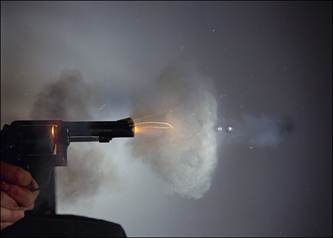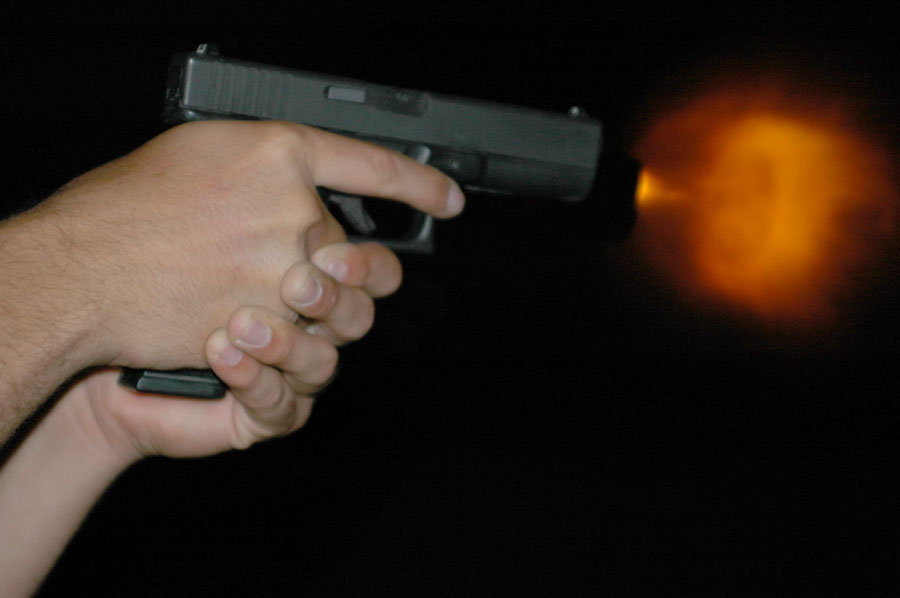

(Taudte et al, 2016) (Vachon and Martinez, 2019) Given the variety of both inorganic and organic substances that may accompany GSR, collection and processing of samples for both can aid in identification.
#HOW TO IDENTIFY THE SOUND OF A GUNSHOT SKIN#
However, skin oils and lotions can interfere with organic GSR detection. Organic GSR can be detected on the hands up to several hours after discharge despite losses due to evaporation and skin permeation. Such compounds may be derived from sources other than firearms discharge. Such organic compounds most often detected include diphenylamine, dibutyl phthalate, ethyl centralite, 2,4-dinitrotoluene, and methyl centralite. Additives include stabilizers, plasticizers, deterrents, coolants, flash inhibitors and other components intended to improve the performance of the powder. The explosives can include a single-base of nitrocellulose or a dual base with both nitrocellulose and nitroglycerine. These organic residues derive from the so-called "smokeless powder" typically utilized in small arms ammunition. Organic GSR primarily comes from materials derived from the propellant powder and are compounds classified either as explosives or additives based on their chemical composition. Even a "blank" cartridge consisting of the casing, propellant, and primer cap, but without the bullet, will produce GSR when fired. (Martiny et al, 2008) (Dalby et al, 2010)Įven lead, barium, and antimony may be retrieved when ammunition primers were presumably lead free, because of contamination by previous firing with lead-based primers. Both titanium and zinc are commonly used in paints and can be contaminants, but the appearance of particles containing them can be distinguished from gunshot residue by SEM. So-called "lead free" ammunition may contain one or more elements including strontium (Sr), zinc (Zn), titanium (Ti), copper (Cu), antimony (Sb), aluminum (Al), or potassium (K). (Blakey et al, 2018) Primer elements may be easier to detect in residues because they do not get as hot as the powder. A mercury-fulminant based primer may be found in ammunition manufactured in Eastern Europe, while sinoxid type primers are used in the West.

Less common elements in GSR include aluminum (Al), sulfur (S), tin (Sn), calcium (Ca), potassium (K), chlorine (Cl), copper (Cu), strontium (Sr), zinc (Zn), titanium (Ti), or silicon (Si). Some bullet coatings may also contain nickel. Bullet jackets are usually brass (90% copper with 10% zinc), but some are a ferrous alloy and some are aluminum. Bullet cores are most often lead and antimony, with a very few having a ferrous alloy core.

Primer cases are of similar composition (Cu-Zn). Virtually all cartridge cases are made of brass (70% copper and 30% zinc). The cartridge case, bullet, bullet coating, and metal jacket contain specific elements that can be detected. Thus, zinc (Zn) and titanium (Ti) would be found in residue.
#HOW TO IDENTIFY THE SOUND OF A GUNSHOT FREE#
Heavy metal (lead) free primers can have zinc peroxide, titanium powder, tetrazene, diazonitrophenol, and nitrocellulose.

A commonly used lead-based primer contains the shock sensitive explosive lead styphnate, oxidizer barium nitrate, and antimony sulfide fuel, yielding residue metals lead (Pb), barium (Ba), and antimony (Sb). Residues often derive from the primer cap mixture of components including an explosive, oxidizer, fuel, frictionator, sensitizer, and binder. Residues can be either inorganic or organic in nature. This residue, called gunshot residue (GSR), can consist of both burned and unburned primer or powder components, combined with additional residue from the surface of the bullet, surface of the cartridge case, and lubricants used on the firearm. (Pun and Gallusser, 2007) Composition of Gunshot Residueįiring a weapon produces combustion of both the primer and powder of the cartridge, creating an expanding plume of gas with smoke containing the residues of combustion. Unburned gunpowders can have recognizable shapes, colors, and sizes of grains. Progressive burning: gunpowder grains that are multiperforated and rosettes that have a burning surface area that increases continuously as the grains are consumed. Neutral burning: gunpowder grains that are single perforated and the burning surface area remains relatively constant. The burning rate of gunpowder can be classified in three categories:ĭegressive (regressive) burning: gunpowder grains formed in flakes, balls, and sticks have a burning surface area that decreases continuously as the grains are consumed. In an explosion something gets very big very fast. Return to Criminalistics Laboratory Methods.įirearms Tutorial menu Examination of Gunshot Residue Appearances of GunpowderĪll gunpowders are designed to burn quickly to produce rapid expansion of gas in a confined space.


 0 kommentar(er)
0 kommentar(er)
